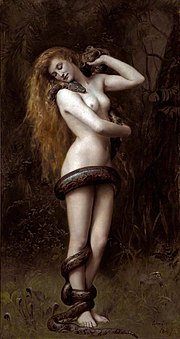Mother superior

Tamara de Lempicka, Adam and Eve (ca. 1932)
Creation is so central to Genesis that the opening chapters of the Hebrew Bible devotes not one but two stories to the idea. Whereas Genesis' first creation myth describes the formation of earth in six days, version 2.0 is entirely anthropocentric. The second account focuses on the creation of Adam and of Eve.
Creation 2.0 partially neutralizes the fallacious dominion ethic that appears in the first myth. Chapter 1's command that humanity "subdue" the earth and "have dominion over the fish of the sea, and over the fowl of the air, and over every living thing that moves upon the earth" now yields to chapter 2's description of Adam's mission "to dress . . . and to keep" the garden of Eden. Gen. 2;15. The second creation account thus substitutes a stewardship ethic in place of the first account's dominion ethic.But the second account interjects an environmentally and socially destructive notion in its own right: the subjugation of Eve. Adam famously takes temporal precedence over Eve, and the consignment of Eve to subservience under Adam results from her comparably culpable role in the Fall. The Book of J, putatively written by a woman, casts Eve's curse (Gen. 3:16) in particularly vivid terms:
To the woman [Yahweh] said: "Pain increasing, groands that spread into groans: having children will be labor. To your man's body your belly will rise, for he will be eager above you."
 As The Masks of God: Occidental Mythology tells the tale, the subjugation of Eve arose from the Hebrew people's rivalry with Canaanites whose "principal divinity" consisted of the goddess Asherah and her consort, a serpent. The Hebrew insistence on the primacy of their male god, according to Joseph Campbell, broke sharply from the mythology of the late Stone Age and the Bronze Age, effecting a perfect reversal of creation's "pictorial message to the heart" and its "verbal message . . . to the brain." In most agrarian creation myths, the serpent as the animal closest to earth and as a phallic emblem would represent the masculine element of a divine creative force, not the embodiment of evil.
As The Masks of God: Occidental Mythology tells the tale, the subjugation of Eve arose from the Hebrew people's rivalry with Canaanites whose "principal divinity" consisted of the goddess Asherah and her consort, a serpent. The Hebrew insistence on the primacy of their male god, according to Joseph Campbell, broke sharply from the mythology of the late Stone Age and the Bronze Age, effecting a perfect reversal of creation's "pictorial message to the heart" and its "verbal message . . . to the brain." In most agrarian creation myths, the serpent as the animal closest to earth and as a phallic emblem would represent the masculine element of a divine creative force, not the embodiment of evil.
John Collier, Lilith (1887)
The sexually hierarchical nature of Genesis' second creation story has long-term negative consequences for equality between women and men and for global well-being. Among the world's religious traditions, only the Abrahamic religions of Judaism, Christianity, and Islam -- with the striking exception of the Catholic variant of Christianity -- insist on a strictly masculine representation of God. Lest we forget, nothing degrades human culture and its relation to nature faster than the systematic denigration of women.
Two of those Abrahamic religions, Islam and Protestant Christianity, are among the most successfully evangelistic systems of belief that the world has ever witnessed. From a single meme evidently designed to give the Jewish people a religious shibboleth relative to their Canaanite neighbors stems an entire family of belief traditions that find no room for a feminine expression of the divine. Far more than the act of heeding the Mother of All Being's assertion that the knowledge of good and evil would confer power on par with Elohim, this deprecation of female divinity represents the true Fall of Man.
And all this explains why, on those occasions when I feel moved to speak not merely of God but to God, I make sure I address Her as "Our Mother."
Next in this series: The adaptive origins of creationist mythology.












0 Comments:
Post a Comment
<< Home